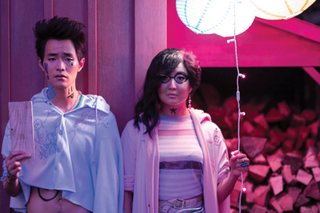
Netflix’s ‘Tales of the City’ is a Set of Cliches But in Queer
The show brings nuance to numerous angles of queer life and chapters of the intersectional queer struggle.

As a gay man, I’m attuned to how much visibility characters like myself get onscreen. So, when I heard that Tales of the City was out on Netflix, I did what any self-respecting person would do and binge-watched it over the weekend.
I hadn’t heard of the Tales of the City series before Netflix decided to revive it this year. The show broke new ground over three seasons, through the 90s and early 2000s.
From the outset, I knew that this was going to be a feel-good series, where everything works out in the end. The story follows Mary Ann (played by Laura Linney), the prodigal straight daughter as she returns home to Barbary Lane, two decades after trying to make a career for herself as an actress in infomercials. Barbary Lane is personified by Anna Madrigal, a transwoman (played by Olympia Dukakis)whose three-story house is the epicenter of queer life in San Francisco. The return of Mary Ann – who, it seems, is perpetually in the process of returning to Barbary Lane and finding her place there – is quickly complicated when she learns that her estranged adopted child, Shawna (played by Ellen Page) believes that she is her biological mother. Mary Ann’s desire to ‘set things right’ ensures that she is sucked right back into her large, adoptive family’s lives. Her re-entry to the household is smoothened by Michael, (played by Looking star Murray Bartlett), her pseudo-adopted gay brother and staunch ally, who lives at Barbary Lane with Anna. Other residents include Margot and Jake (May Hong and Garcia respectively), the erstwhile lesbian, now queer couple after Jake’s transition; the twins Jonathan and Jennifer Winter (Christoper Larkin and Ashley Park); and Shawna (Ellen Page).
As the plot unfolds, one thing becomes clear: Tales of the City is the gayest thing I’ve ever had the delight of watching. All the writers are queer. Trans actors actually play trans roles, which is still rare, even in 2019. This fact smoothens what turns out to be an occasionally bumpy ride.
Related on The Swaddle:
‘The ‘Other’ Love Story’ Portrays Accessible, Relatable Same‑Sex Relationships
There is a healthiness to the dynamics of everyone non-heterosexual with other characters. Nine times out of ten, it’s the straights who don’t have things figured out. Despite finding themselves in messes, most queers on the show know how to clean things up, for the most part.
While Mary Ann’s dynamic with her nondescript, homophobic husband Robert Watson (played by Michael Park) and Brian, her ex-husband, is straight out of a marriage counselor’s nightmare, Margot and Jake are open and honest with each other through their struggles around identity, owning and vocalizing their complicated feelings around Jake’s transition. Until almost the very end, even Michael and Ben, his boyfriend (played by Charlie Barnett), keep things together. “Jealousy is never sexy,” he says to Ben.
The friendships that the queer characters build with each other are tellingly healthy and supportive, exactly the sort of environment you’d want any marginalized person to grow up in. These are best illustrated in fine touches such as when Margot and Shawna talk about the former’s relationship, or when Shawna makes sure to tuck Jake in when he is sleeping.
Another strength is the way Tales of the City deals with intergenerational conflict. This is best personified by a dinner where Ben stands up against the older generation’s racist transphobia. It pits the current intersectional queer struggle against the traumas faced by the earlier generation of the gay liberation movement. The older men clearly fail to see that their struggles could easily resonate with queer intersectional feminists of today. Instead, they get defensive, attacking Ben for calling them out, declaring that their past difficulties give them enough reason to be offensive. Artfully, the viewer sees both perspectives, while refusing to condone the problematic perspective of the older gay men. The conversation is one of the show’s highest points.
Another storyline that hits home is Margot’s search for her identity after Jake’s transition. The difficulty the other half of a transitioning couple experiences is often not discussed in mainstream media. Margot’s struggle to want to continue identifying as a lesbian despite her feelings for her now trans boyfriend and her eventual decision to put herself first is a key plot driver, albeit with weak acting. Without revealing too much, the tension between the pair is resolved with what is the basis of the entire show: the understanding that people can love each other for who they are as human beings above all else.
Together, the cast succeeds in making Barbary Lane a living, breathing entity through Anna Madrigal. Through the space and the person, all the pieces of the characters’ lives fit together to make a palatable rainbow. The characters’ occasional slapstick and absurd humor does leave the viewer in giggles and side stories, such as that of Jake’s family, which rounds off the narrative beautifully.
Yet, somehow, despite its high moments and cohesive cast, it fails to deliver. The clichés come hard and fast right from the first episode and make you want to give up before you truly begin. Mary Ann’s character is a tired one; her relentlessness lacks vision or direction, and her character development is erratic. For example, her newly discovered ability to start empathizing with everyone around her takes place suddenly and does not square with the initially egoistic character we are presented within the first episode.
Related on The Swaddle:
Netflix’s ‘Sabrina’ is Not the Woke Feminist Show It Thinks It Is
Tales of the City also has other minor hiccups that mar the experience. A conversation about Ben being a stickler for neatness leads to characters labeling his behavior as Obsessive Compulsive Disorder, a trivialization of a debilitating mental illness, which grated on my nerves. Occasionally, some characters are squandered on bad arcs and some plots squandered on actors. Wrenita, who mixes the tropes of counselor best friend and rebound to Brian, from whom you’re aching for more, suddenly just falls off the plot cliff and is never heard from again. Margot and Jack’s emotional tug of war takes place with Margot’s character struggling to uphold her end of the bargain.
Even though it often feels like the queer perspective is being explicitly narrated at points rather than letting it breathe on its own, the show’s good moments still make it worth watching. Every character shows their vulnerabilities without asking that they be fixed, just that they be seen. “I guess we’re all broken but I don’t think we’re unfixable,” says Shawna when she gives an old flame a long overdue apology. This is remarkably wholesome and progressive in its own right.
Tales of the City is about leaving and coming back. Eventually, I lost track of which is which anymore, leading me to think of gay author James Baldwin’s words, “Perhaps home is not a place but simply an irrevocable condition.” More importantly, Tales of the City is about learning when leaving is for the right reasons and for the wrong ones. “Last time I felt like I was running away, this time I feel like I’m running towards something,” says Shawna in the last episode. This, if anything else, is the biggest take away from the show.
As a newcomer to the series, I felt like I have watched bits and pieces of this show in other places. Just as expected from every other feel good find-yourself-homecoming mish mash, Tales of the City leaves you with a decently satisfying aftertaste. It is a big step in the right direction, treating themes of intersectional feminism, gender norms, exploration of the self, homecoming, intergenerational conflict and identity with more ease and grace than you’d expect. Unfortunately, since so much energy is devoted to doing so, the plot itself comes out looking tarnished. All in all, the show washes over you like tepid hot chocolate with some slightly too crunchy marshmallows: worth having, but not too much.
Correction: An earlier version of this article described the show’s agenda as “non-binary.” Tales of the City does not have any non-binary characters or storylines. The article has been updated accordingly.
Based in Paris, Alaric Moras has a B.A. in English Literature and an M.A. in International Affairs. He writes fiction and non-fiction around issues of gender, queerness, politics, language and foreign policy. He loves dogs and all kinds of food and thinks the world would be a different place if we all tempered our discourses with love, vulnerability and empathy. His favorite authors are Gabriel Garcìa Marquez, Arundhati Roy and Philippa Gregory.
Related


Research into Porn’s Detrimental Effects Is Conflicting
